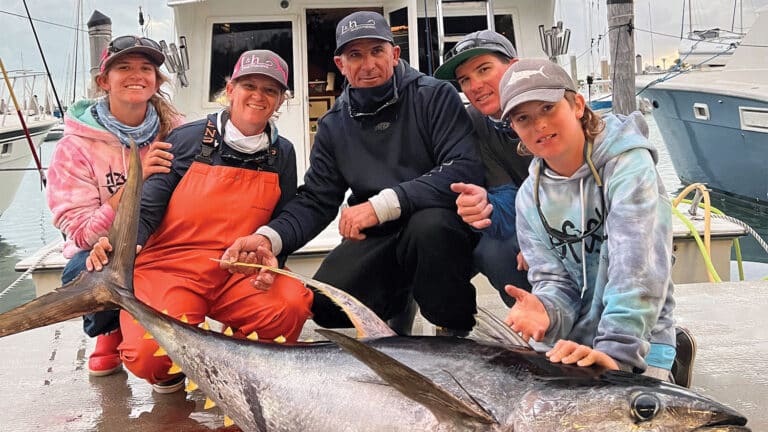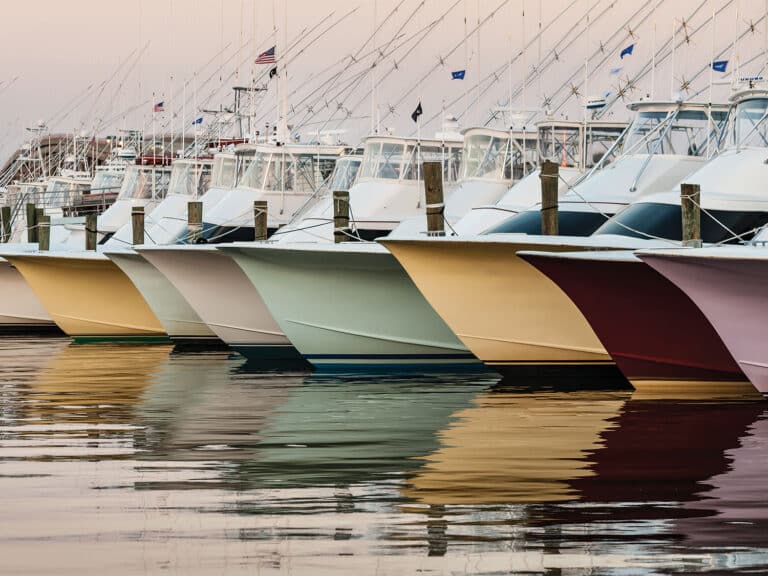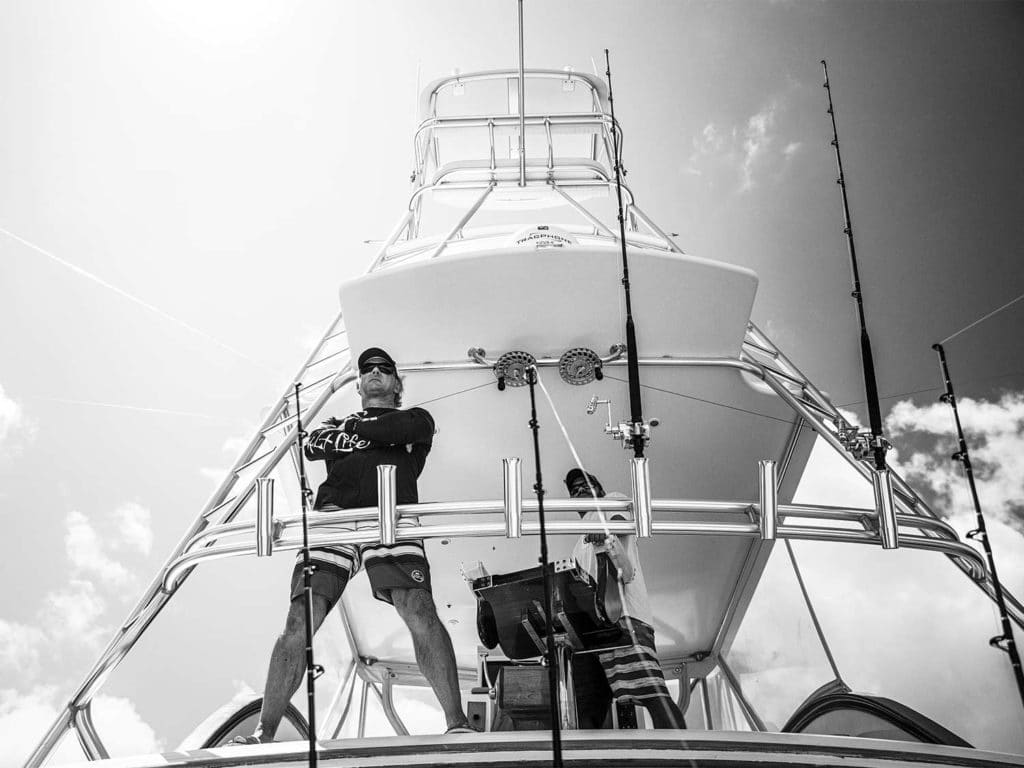
We eased into the Pocket after an uneventful run across the shallows of the Great Bahama Bank from Bimini, and were immediately struck by how textbook-perfect the conditions looked. A southeast breeze had been pushing through the area for a few days, and the flying fish were stacked up thick, right along the edge. A falling tide was pulling water off the bank and sweeping across the deep drop-offs. Frigate birds wheeled overhead, occasionally dipping low to pick off a winged snack spooked into flight by wolf packs of prowling dolphin.
Capt. Skipper Gentry eased back the throttles as Carolina Gentleman, his 60-foot custom Carolina-built charter boat, transitioned into fishing mode. In the cockpit, we barely had the spread complete before the first gaffer-size green hornet pounced on a long-rigger ballyhoo. Deckhand Clay Gaffney made it feel right at home in the icy fish box, where it was quickly joined by several others.
Around lunchtime, we switched gears and put out the wahoo spread. As we were tacking up and down the edge off the Joulters toward Andros, wahoo came calling; the first weighed in the high teens, but the next two—a doubleheader—were respectable fish in the 30-pound-class range. They joined the pile of mahi already residing in the fish box. As we reset the spread and made another turn, Gentry suddenly pointed to port and said, “Look at the size of that blue marlin!” The fish paddled lazily past the boat, a massive shadow in the clear, cobalt-blue water. Incredible. Gaffney and I looked at each other, then back at our wahoo spread—as unlikely to tempt a big blue as a rubber bass worm—and just laughed. You never know what to expect fishing here. Did I mention that it was the second week of December? Welcome to the Pocket.
Location Is Everything
This compact piece of water from the Northwest Channel light to the Joulter Cays is well-known for producing outstanding fishing, thanks to several key factors. The first is location, and the extreme depths of the water. The Pocket is at the northern end of the Tongue of the Ocean; the edge is just over a mile from the island of Andros, and it’s a near-vertical drop all the way around the perimeter. According to Gentry, it drops to over 1,100 feet just a few miles off the rocky shores of his second home overlooking a gorgeous bonefish flat near Morgan’s Bluff on the northern end of Andros. Chub Cay is only about 12 miles east-northeast.
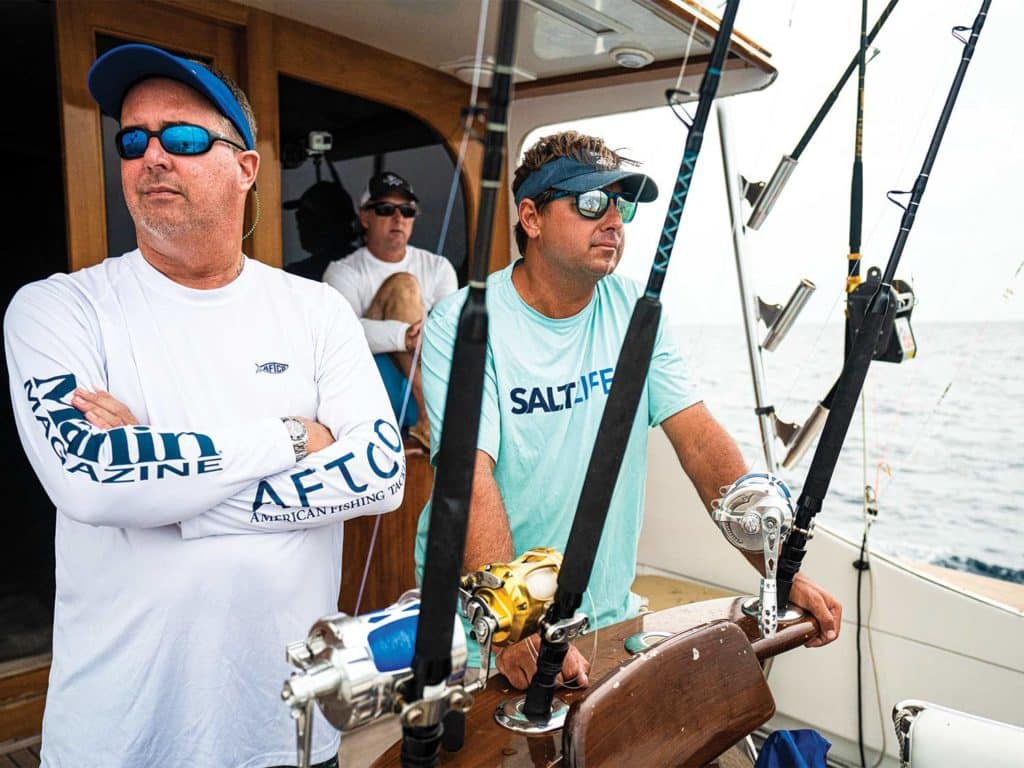
Because of the geography, the Pocket is dependent on the wind to provide optimal fishing conditions. A southeast breeze is perfect, especially when it blows that direction for up to a week. “The bait really stacks up, and that’s when the fishing can go from good to really incredible,” Gentry says. “Last May, we had those kinds of conditions for a week. In four days, our charter clients hooked 12 billfish—a mix of blues, whites and sails—plus we had some really good dolphin fishing. When it’s on, it’s on.” But, as he points out, it’s up to the weather gods. West wind in the forecast? Might as well stay home and tackle the honey-do chores, or put another coat of wax on the boat.
Another attractive feature is the Pocket’s accessibility. It’s about 130 or so miles from southern Florida, depending on your departure inlet. For Gentry’s Andros-based operation, the fishing is practically at his doorstep. “I like the fact that we’re not running over fish at 25 knots on the way out,” he says. “We only have to go a couple of miles and we’re ready to fish. And while I don’t recommend it, this is one of those places where you can go marlin fishing for just a half-day if you wanted to.” He related the story of a trip last season, where his charter group wanted to check out one of Andros’ famous blue holes in the morning, then fish for a bit in the afternoon. Carolina Gentleman departed the dock in north Andros at the stately hour of 1 o’clock; they released a white marlin right off the bat for their first-time angler, and fought a 500-pound blue marlin for over an hour until it finally pulled the hook. An action-packed afternoon, and still back in time for cocktails.
Watch: Learn to rig a bonito strip teaser.
Seasons and Spreads
While the bite can go off pretty much any time in the Pocket, Gentry says it really gets consistent starting in April and May. The wahoo are thick in the wintertime, which is a bonus for those looking for some offseason action, plus a fish box full of fillets. And as we saw, the blue marlin can appear anytime. Again, it’s more dependent on the wind to produce the right set of parameters, pushing bait and gamefish into the area.
Since it’s definitely a multispecies fishery, Gentry has something for everyone in his typical spread. On our trip, we used a pair of Squidnation Flippy Floppy squid chains for the bridge teasers, then added a pair of medium-size lures on the short riggers, fishing everything on 50Ws. Gentry prefers to use tag lines for his short-rigger lures, which reduces the drop-back, keeping the lures swimming in precisely the same spot. They will run a variety of brands, but as with other crews, they feel that the lure’s action and correct placement in the spread mean more than the manufacturer, although darker colors do see more time in the water. The long riggers sport a pair of rigged ballyhoo—circle hooks for billfish or J hooks and Ilanders if tuna or dolphin are more prevalent. Gentry also fishes a bridge rod way back in the spread with a swimming ballyhoo, occasionally switching to a cedar plug for tuna. He will add a pair of chin-weighed ballyhoo on the flat lines, or if his anglers prefer to pitch, they stay in the boat until a fish is raised on the teaser.
For wahoo fishing, it’s time to haul out the big guns. We used 80Ws on bent-butts and fished a variety of heavy, bullet-nosed wahoo specials behind trolling weights, with an orange-and-black Yo-Zuri Marauder plug swimming on the right short. That one was a fish favorite, getting crushed several times, until one particularly nasty wahoo torqued the front hook hard enough to snap it completely off. We swapped it out for a purple-and-black version, and it got whacked a few times as well.
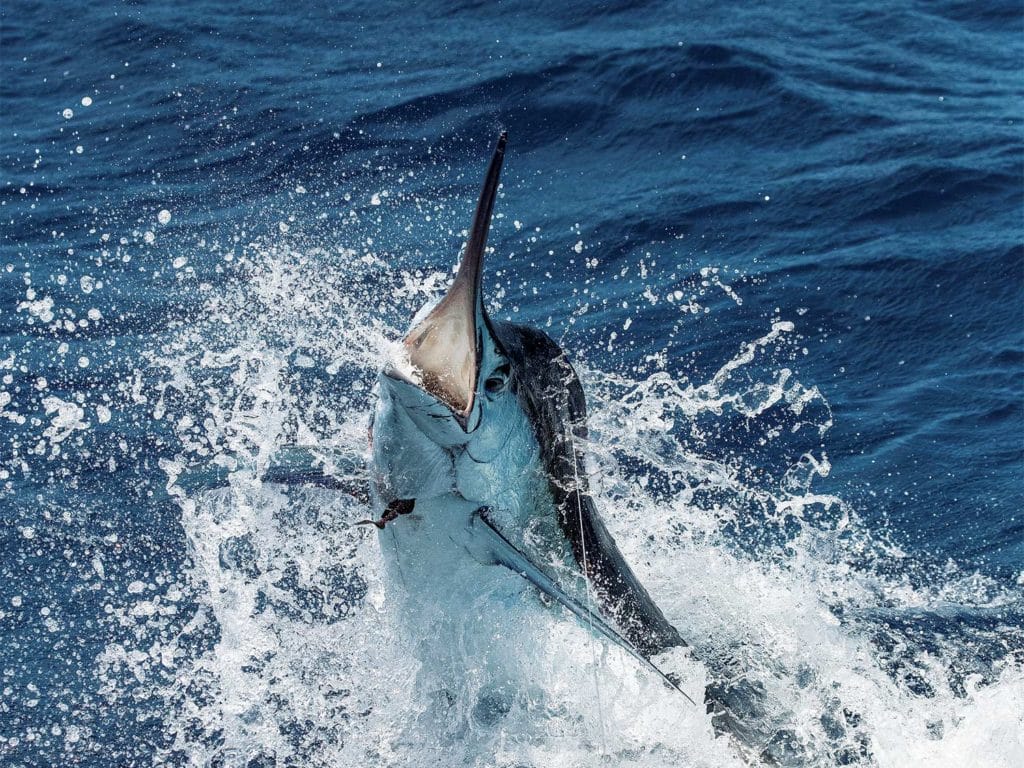
Stay and Play
In early January 2020, Gentry was midway through construction of the first of three homes he’s building at Morgan’s Bluff, which will be set up as top-shelf fishing lodges. Situated overlooking some of the island’s most productive and beautiful bonefish flats and about five minutes from the small marina where Carolina Gentleman is home-ported in the season, they will be a popular choice with visiting anglers.
“I wanted to build a lodge on Andros specifically because of what it doesn’t have,” Gentry says. “It’s a blank slate. That’s really what drew me here—the natural beauty—plus the fact that we’re only a few miles from the Pocket.” Andros is the largest island in the Bahamas, and in fact it has more landmass than all the other 700 or so islands combined, yet it’s home to just 8,000 full-time residents.
Accessibility was another key factor in his decision. Nassau, the national capital of the Bahamas, is only about 30 miles away on the island of New Providence, giving his clients easy international access, with multiple interisland airlines flying daily to Andros. He will be adding a second sport-fisher and already has a small fleet of bonefish skiffs for those who want to take advantage of Andros’ world-class inshore fishery. Gentry also plans to expand the marina with additional dockage, but he admits that space there will be limited.
Read Next: Learn to rig your marlin lures correctly.
The primary jumping-off point for those fishing the Pocket remains at Chub Cay, about 130 miles from southern Florida. The beautiful private island, located at the southernmost tip of the Berry Islands, has a new clubhouse with a full-service hotel, restaurant and bar, plus an infinity pool, private beach cabanas, and villa rentals for larger groups. The 109-slip marina has floating concrete docks for vessels up to 190 feet, with upgraded 30-/50-/100-amp power available, in addition to water, fuel, ice, high-speed wireless internet and a well-stocked ship’s store.
Kamalame Cay is another private island for those who really want to get away from it all, and do so in grand style. It’s a 96-acre cay just off the eastern coast of Andros, with gorgeous seaside villas and a small marina, although there is no fuel or customs service available; Kamalame is accessible only by boat, helicopter or seaplane.
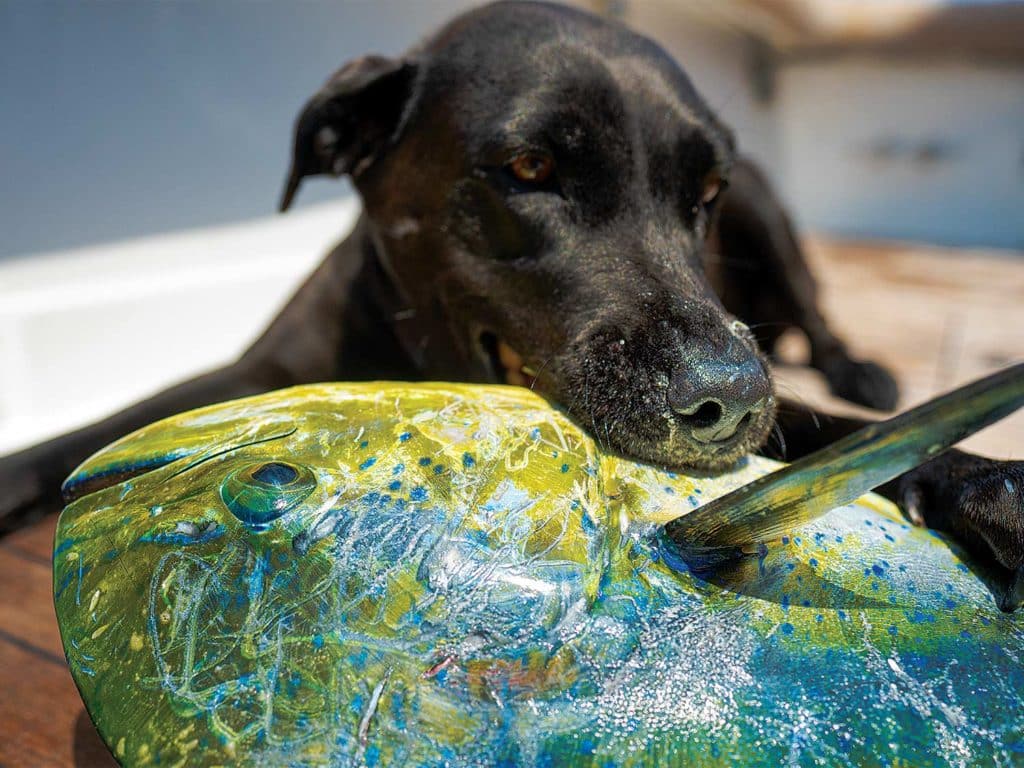
Holes of Blue
Not surprisingly because it’s the sixth-longest barrier-reef system in the world, the area offers amazing inshore fishing, especially for bonefish. Gentry says that because there is virtually no fishing pressure, Andros bonefish are not only plentiful, but also easily stalked on the flats using either spin or fly tackle. He uses local guides who have fished these waters their entire lives.
The snorkeling and diving are also top-notch, given the historically gin-clear waters. On Andros, the blue holes are a major draw as well—these water-filled cave systems attract divers from all over the world. While most of the primary Bahamas islands have blue holes, the ones on Andros are among the most well-known, with 178 on land and another 50 along the shallow banks just offshore. They range in depth from 30 to hundreds of feet.
Whether you’ve never ventured to this area before or if it’s been a few years since you’ve fished there, this is the time to seriously consider putting together a trip to the Bahamas. Be flexible with the dates, and keep an eye on the wind—when it clocks around to the southeast for a few days, it’s time to pull the trigger. You just might hit it big in the Pocket.
Chub Cay Invitational
The first annual Chub Cay Invitational is slated for April 2-4, 2020, hosted by the Chub Cay Resort and Marina Club. The inaugural event will feature two days of fishing for blue and white marlin plus sailfish in an all-release format, as well as gamefish divisions for tuna, dolphin and wahoo. The tournament is open to Chub Cay members and the general public, and is designed to showcase the natural beauty and amenities of the resort and marina, which was spared any significant damage from Hurricane Dorian in 2019. Tournament director Robert “Fly” Navarro says: “We just want people to fish the way they normally do and to have a good time. Chub Cay is accessible to sport-fishers as well as large outboard boats, so we want everyone to enjoy what the Bahamas has to offer.”





